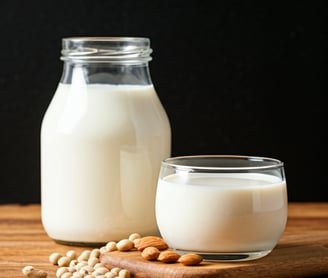Cargill and Cubiq foods: Fat Replacement Solutions for Dairy Alternatives
SUSTAINABILITYALTERNATIVE PROTEINSDAIRY & ALTERNATIVES


As consumer demand for plant-based alternatives continues to rise due to health, sustainability, and ethical considerations, the challenge to replicate the taste, texture, and functionality of traditional dairy products has become more pressing. In a groundbreaking patent, Cargill and Cubiq Foods have collaboratively developed a novel dairy substitute product featuring an innovative oil-in-water emulsion that addresses these challenges. This invention promises significant advancements in the plant-based dairy space, particularly for cheese substitutes.
Background: The Challenge of Mimicking Dairy
Traditional dairy products, such as cheese, yogurt, and cream, are highly complex in composition. They derive their sensory appeal from milk fats and proteins, which contribute to their texture, mouthfeel, and flavor. Replicating these properties using plant-based ingredients has been a significant hurdle for the industry.
The need for plant-based dairy substitutes is growing as consumers shift toward vegan diets or seek to reduce their intake of animal-derived products. However, many current plant-based options fall short in texture, flavor, and nutritional composition. The new invention aims to bridge this gap by providing a dairy substitute product with enhanced properties that closely mimic traditional dairy.
Core Invention: The Role of Oil-in-Water Emulsions
The patent application introduces a novel approach to creating plant-based dairy substitutes by incorporating an oil-in-water emulsion into the product formulation. The emulsion is stabilized using plant proteins and hydrocolloids and serves as a functional fat replacer that mimics the mouthfeel, creaminess, and texture of dairy fat. This approach has multiple benefits:
Fat Reduction: The emulsion reduces the saturated fat content typically found in traditional dairy fats, aligning with consumer health preferences.
Texture Improvement: The combination of hydrocolloids and plant proteins creates a gel-like structure that mimics the creaminess and elasticity of dairy.
Versatility: This emulsion can be used across various plant-based dairy products, including cheese substitutes, desserts, and ready-to-eat meals.
Key Components of the Dairy Substitute
The dairy substitute product comprises:
At Least One Dairy Substitute Ingredient: These include plant-based proteins, carbohydrates, or aqueous solutions. Examples of proteins include pea protein, which provides nutritional value and structural support.
Fat in the Form of an Oil-in-Water Emulsion:
Lipid Phase: Made from vegetable oils, such as sunflower oil, providing a healthier fat alternative.
Hydrocolloids: Functional additives like konjac fiber and agar-agar stabilize the emulsion, improve gel formation, and enhance the product's texture.
Plant Proteins: Pea protein is a key component, offering functional and nutritional benefits.
Final Composition:
Aqueous solution: 35-55% of the total product.
Proteins/carbohydrates: 18-40%.
Fat: 5-40%, depending on the specific application.
Applications and Use Cases
The invention has broad applications across the plant-based food industry:
Cheese Substitutes: Blocks, slices, and shredded cheese alternatives with enhanced meltability and stretch.
Plant-Based Products: Vegan yogurt, cream cheese, sour cream, and desserts.
Food Products: Incorporation into pizzas, pasta, sauces, and ready-to-eat meals.
In addition to its versatility, the oil-in-water emulsion significantly reduces saturated fat levels in plant-based dairy substitutes, addressing consumer health concerns.
Manufacturing Process
The patent outlines a straightforward method for creating the dairy substitute product:
Preparation of the Emulsion:
Combine plant proteins, hydrocolloids, and vegetable oils in a water phase.
Stabilize the emulsion through controlled mixing and gelling.
Incorporation into Dairy Substitute Base:
Blend the emulsion with other plant-based ingredients to achieve the desired texture and composition.
Shaping and Final Processing:
Shape the product into blocks, slices, or other forms, depending on its intended use.
Benefits of the Invention
This new formulation introduces several key advantages:
Improved Sensory Experience: The use of hydrocolloids and proteins enhances the texture and mouthfeel of plant-based products, making them closer to traditional dairy.
Healthier Composition: Reduced saturated fat content and the use of plant-based ingredients align with current dietary trends.
Clean Label Appeal: By using natural hydrocolloids and proteins, the product meets consumer demands for cleaner, more natural formulations.
Sustainability: Replacing animal-derived ingredients with plant-based alternatives supports sustainable food production.
Cargill and Cubiq Partnership
The partnership between the two companies expanded in 2023 when Cargill integrated Cubiq's novel fat solutions to its plant based solutions, spanning plant proteins, texturizers and a full array of traditional fats and oils. This innovation is the next step in their partnership for building plant based solutions portfolio.
